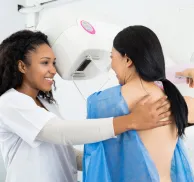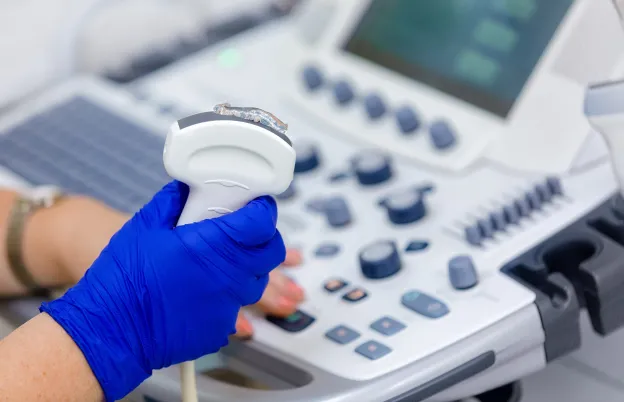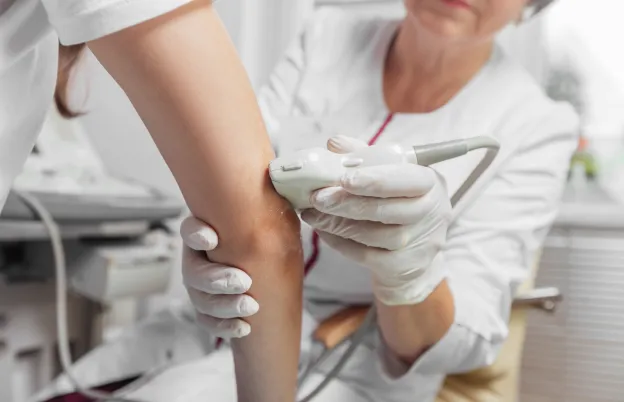What Is Musculoskeletal Ultrasound?
Musculoskeletal (MSK) ultrasound is a valuable tool doctors and sonographers use to help them diagnose and treat injuries. MSK ultrasound uses sound beams that emanate from a probe to reflect off soft tissue and back to the probe. The probe has many transducer elements that process the signal and translate it into an image. These images can then be used to diagnose and treat musculoskeletal diseases like tendinopathy or overuse injuries, such as tendon tears, muscle injuries, and ligament injuries. While it may seem like a new modality to some, MSK ultrasound has actually been around for decades, but it has become much more popular over the past 5-10 years, especially in the United States.
MSK ultrasound can be used to diagnose and treat a wide variety of issues beyond performing the ultrasound, including guided steroid injection, ultrasound guided lavage for calcification in the rotator cuff, platelet-rich plasma therapy, and nerve ablation for peripheral nerve pain. Its broad application makes it a vital tool for doctors and sonographers to have at their disposal.
Difference between MSK Ultrasound & MRI
When people think of diagnostic imaging, they probably envision magnetic resonance imaging or MRI. Through the use of magnetic fields, magnetic field gradients, and radio waves, MRI scanners can generate images of organs, bones, and blood vessels in the body. Rather than thinking of these two forms of diagnostic imaging as competing with one another, it’s more accurate to view them as complementing each other.
Field of View
With an MRI, doctors can obtain a larger field of view. An MRI allows the technologist to obtain an image of an entire shoulder, for example, including the rotator cuff, humoral head, cartilage, and the labrum. MSK ultrasound, on the other hand, creates more of a pinhole image that would allow the doctor or sonographer to concentrate on a specific area, such as only the rotator cuff. In this example, an MSK ultrasound would be useful for diagnosing a rotator cuff tear, but an MRI would be more helpful for the purpose of diagnosing arthritis.
Dynamic vs Static
Another difference between MSK ultrasound and MRI is that ultrasounds are highly dynamic. During the procedure, a doctor would be able to move the shoulder to look for impingement or tendon subluxation, or to guide a needle into a small space. MRI imaging is a static modality. The patient must remain perfectly still while the MRI scanner is running.
Cost
Beyond the practical differences between the two modalities, a major contrast between the two imaging techniques is cost. MSK ultrasound is considerably more cost-effective than MRI, simply due to the nature of how the machinery operates. Patients may be tempted to view MRI as more authoritative because of the higher cost involved, but as we have illustrated, the usefulness of each modality is determined by the issue at hand, not the inherent cost of operating the tools. As healthcare costs continue to rise, this is an especially important factor for both patients and their doctors to keep in mind.
Uses for MSK Ultrasound
Musculoskeletal ultrasound is a diagnostic tool that has been in use for a few decades but has increased in popularity over the past five to ten years, especially in the United States. This is due to a variety of factors, most notably the improvement of ultrasound technology, the cost-effectiveness of the modality, and the increasing number of doctors and sonographers specializing in ultrasound.
MSK ultrasound can be applied to every joint in your body, from your shoulders to your ankles. It is useful for diagnosing and treating ailments such as:
- Superficial tendon, ligament, nerve, and muscle diseases, such as diagnosing rotator cuff tears in the shoulder, bursitis, tennis or golfer's elbow ailments, and carpal tunnel of the wrist.
- Applications in rheumatology to look for inflammatory changes of the joints or synovitis or erosions using the Doppler capability of ultrasound to look for increased blood flow, also known as hyperemia.
- PM&R (physical medicine and rehabilitation) to diagnose muscle ailments.
- Helping anesthesiologists manage pain by pinpointing peripheral nerves for injectables and diagnosing causes of peripheral neuropathy.
All of these applications for MSK ultrasound are important, but rotator cuff injuries are one of the most common issues requiring musculoskeletal ultrasound. Rotator cuff injuries can be tricky and hard to diagnose and treat. There is a lot of variation from one tear to the next, whether it’s partial or full thickness tear, acute or chronic, and the pinpoint accuracy of MSK ultrasound is especially good at helping obtain images of these types of injuries.
The Future of MSK Ultrasound
As previously mentioned, MSK ultrasound has become increasingly utilized in the last decade due to advances in the technology as innovations in the field continue to develop. Aspects of the modality, such as the high-frequency linear array and the shape of the transducer, allow for increasingly higher-resolution imaging. This enables radiologists and sonographers to achieve higher contrast and get an even more accurate image of things like increased blood flow, meaning in the future MSK ultrasound Doppler flow will likely be the next phase of how MSK ultrasound is utilized.
Another area for increased future potential is called elastography, which looks at tissue stiffness. MSK ultrasound can be used to judge the elasticity of different soft tissues, for example, tendon health to predict rupture or tumors to determine benign vs. malignant.
Guided procedures are also an area of innovation in this interventional modality, with techniques like platelet-rich plasma therapy for tendon overuse injuries, calcific tendinitis lavage, and carpal tunnel and trigger finger release. Percutaneous tenotomy is a procedure that pierces damaged parts of tissue, such as tendons, to help promote the body’s natural healing process. This procedure would be impossible to perform effectively without ultrasound guidance, and the ways in which this method may prove beneficial in the future are yet to be determined. The future possibilities for the application of MSK ultrasound are bright, indeed.
Benefits of MSK Ultrasound for Patients
MSK ultrasound offers specific advantages for diagnosis and treatment over other diagnostic tools, such as MRI and CT:
- MSK ultrasound can be used to treat the underlying issue simultaneously with the diagnosis.
- It is more cost-effective than MRI and CT, which can be quite expensive.
- Patients can be treated more quickly.
- The dynamic nature of the MSK ultrasound makes it easier for doctors to perform certain procedures, such as guiding a needle in real-time through soft tissue, visualizing the needle, and then targeting the joint or nerves for an injectable, such as a steroid.
- Patients report a greater degree of comfort with ultrasound as opposed to something like an MRI; patients must remain perfectly still during an MRI scan, and the procedure can be claustrophobic.
- MSK ultrasounds allow for increased patient interaction since the sonographer can talk with the patient during the procedure and get real-time feedback. This degree of specialist-to-patient interaction helps the entire medical team develop a closer relationship with the patient and also helps ensure patients feel seen and heard.
- Radiologists and sonographers can better serve patients with MSK ultrasound in their toolkit. These experts should ideally be well-versed in an array of modalities, from x-ray to CT, ultrasound to MRI. Expertise in all modalities can be essential.
Dr. Kenneth S. Lee, MD, MBA, Professor of Radiology and Section Chief, Musculoskeletal Imaging and Intervention at the University of Wisconsin School of Medicine and Public Health Madison summarized the many benefits of MSK Ultrasound:
“When we think about quickly diagnosing musculoskeletal injuries so that patients can get back to their work or sport right away – ultrasound is a perfect modality. You can diagnose and treat at the same time, and it’s also cost effective.”
Challenges of Using MSK Ultrasound
Perhaps the biggest challenge of using MSK ultrasound is the steep learning curve. Mastering this modality is not as simple as having the machine or taking a quick online or weekend course. MSK ultrasound is the kind of procedure you have to perform at a high volume in order to become proficient. Developing expertise in musculoskeletal ultrasound takes practice and a lot of time. To be able to devote that kind of time toward learning the modality, or even having the patient volume to necessitate it, can be very difficult. Understanding which ultrasound machine to utilize, including the many different types of ultrasound probes is important. Knowledge of the physics of ultrasound, image reconstruction and artifacts is also important to troubleshoot and maintain a high-quality ultrasound service.
Possessing a thorough understanding of anatomy is essential to effectively providing MSK ultrasounds.
- Where do you place the probe on the skin surface in order to be able to interrogate the correct anatomy?
- Where is the superior cuff?
- What is the greater tuberosity?
- What kind of bony acoustic landmarks do you need to rely on to look for the soft tissue structures so you can properly diagnose tendinopathy or fluid collections?
- What does the pathology look like so you can provide an accurate diagnosis and not over- or under-diagnose?
This kind of specialized knowledge is not necessarily something you already know, or that you may have forgotten by the time it comes up. Learning what you are looking for and at is something that you learn with experience over time. Being able to build up that expertise can be difficult without volume and repetition.
The challenge of being able to serve enough patients over time in order to get enough practice is essential because you can harm patients with ultrasound. You need a deep understanding of the physics of ultrasound and how to optimize the image that you're looking at. It is challenging to properly guide a needle to a target without injuring adjacent blood vessels and nerves. The nuances of ultrasound and the lack of opportunities for practice can be very challenging and create an incredibly steep learning curve.
How to Learn MSK Ultrasound
Now that you understand the inherent challenges in providing MSK ultrasound services, you are probably wondering how you can go about learning MSK ultrasound, especially if your current role does not offer the patient volume to facilitate enough practice.
Thankfully, the steep learning curve is a known issue in the industry, and there are several specialty societies you can turn to for training opportunities.
American College of Radiology:
The ACR offers clinical resources and certification options for radiologists to hone and maintain their skills.
American Institute of Ultrasound in Medicine:
AIUM is a medical association dedicated to advancing the safe and effective utilization of ultrasounds through education, research, and accreditation.
American College of Rheumatology:
ACR is a professional organization that helps develop clinical practice guidelines for the subspecialty of rheumatology.
These are but a few of the organizations offering training and certification opportunities. None of them could be considered “one size fits all,” and none of them would be sufficient as standalone training to consider oneself an expert in MSK ultrasound, and the importance of on-the-job learning cannot be understated. Developing that kind of experience and education is an ongoing, perhaps even lifelong, journey.
RMSK Certification
RMSK Certification, or the Registered in Musculoskeletal (RMSK) sonography certification, allows non-radiology physicians and advanced care providers to demonstrate their proficiency in MSK ultrasound. Offered by the Alliance for Physician Certification and Advancement, the MSK sonography exam tests the knowledge and skills necessary to perform these procedures and reliably provide accurate diagnoses. Practitioners with this certification report having advanced skills and knowledge in MSK ultrasound and the ability to provide improved patient safety and care. To renew certification, participants must seek out and participate in continuing education opportunities that are eligible for CME credit, like the ones offered at Medical Technology Management Institute (MTMI).
Continuing Education
MTMI offers a continuing education MSK ultrasound course, a 3-day comprehensive program from head to toe. MTMI’s program includes both a didactic and a hands-on portion. Class sizes are kept intentionally small, with smaller groups broken up to focus on specific joints and more closely examine the anatomy and pathology with a focus on protocol-driven examinations and hands-on scanning. Because of this format, participants get a considerable amount of hands-on time, with a sonographer, radiologist, or sports medicine physician acting as a proctor.
Dr. Kenneth Lee, MD, MBA is the program director for MTMI’s MSK ultrasound course and was instrumental in guiding this blog post. When asked specifically about the key advantages of this course, he stressed that, “what our participants really enjoy is the hands-on aspect, where they have an ultrasound machine, a probe, and a volunteer who they are scanning the shoulders, elbows, and wrists to the hip, knee and ankles” along with working with targets in phantoms for interventional ultrasound experience.
The one-on-one time with proctors and the hands-on portions of this course are invaluable as they provide real and in-person practice opportunities rather than solely theoretical learning. MTMI programs are taught by experts with national reputations in their fields and cover every modality. Our cross-training courses, offered in the classroom as well as via webinars, offer accredited programs that prepare you for registry exams and to take your career to the next level.
Check out our full catalog of programs or contact us with questions today!











